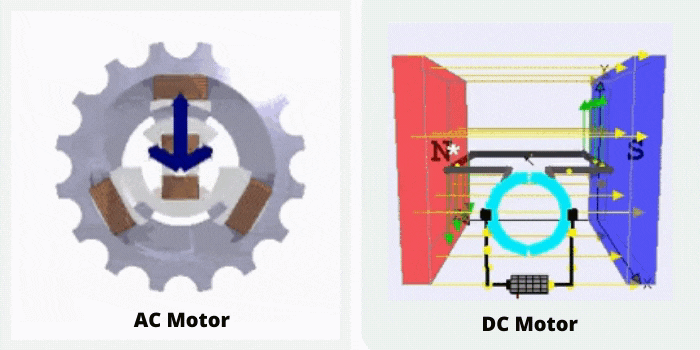AC Motor and It’s Mechanism
In an AC motor, there is a hoop of electromagnets organized across the outdoors (making up the stator). Which can be designed to provide a rotating magnetic field. Inside the stator, there’s an axle made of solid metal, a loop of wire, a coil, a squirrel cage made of metal bars, and interconnections. There are also some other freely rotating metal parts that can conduct electricity.
The rotor, suspended inside the magnetic field works as an electrical conductor. Because of its rotation, the magnetic field keeps constantly changing. According to Faraday’s law of electromagnetism, the magnetic field produces (or induces) an electric current inside the rotor. If the conductor is a ring or a wire, the current flows around it in a loop. If the conductor is simply a solid piece of metal, eddy currents swirl around it instead.
Either way, the induced current produces its own magnetic field and, according to another law of electromagnetism (Lenz’s law) tries to stop whatever it is that causes the rotating magnetic field—by rotating as well. AC motors offer a relatively efficient method of producing mechanical energy from a simple electrical input signal.
DC Motor and It’s Mechanism
These motors are based on a piece of wire bent into a rectangular loop. This loop is suspended between the poles of a magnet. Through hooking up a wire and connecting it to a battery, there’s a flow of direct current (DC) through it and thus a temporary magnetic field is produced all around it. This temporary field repels the original field from the permanent magnet, causing the wire to flip over.
Normally the wire would stop at that point and then flip back again. But if an ingenious, rotating connection used (which is called a commutator), the current can be reversed every time the wire flips over. This means the wire will keep rotating in the same direction for as long as the current keeps flowing. The essence of this simple DC electric motor was conceived in the 1820s by Michael Faraday and turned into a practical invention about a decade later by William Sturgeon.
Difference Between AC and DC Motor
Without the primal distinction, that is the input of alternate and direct current AC and Dc motors have several other differences.

